Terms and Conditions Agreement for Dropshipping

If you have a dropshipping business or run an ecommerce store, you should have a Terms and Conditions agreement in place.
While there's no set template you need to use, every Terms and Conditions agreement should include certain clauses to help protect your business and prevent disputes arising from customers.
Let's break down what your Terms and Conditions agreement should include if you run a dropshipping business, and where you should display the agreement on your platform.
Need Terms and Conditions for your business? We can help you generate a customized Terms and Conditions agreement in around two-three minutes for free. Try our Terms and Conditions Generator and just follow these steps:
- Click on the "Create your Terms and Conditions today" button.
- At Step 1, select the where will you use your Terms & Conditions and click "Next step":
- Add information about your business:
- Select the country and continue to the "Next step":
- Answer the questions about your business practices and click "Next step" when finished:
-
Enter your email address where you'd like your agreement sent and click "Generate."

You're done! Now you'll be able to instantly access and download your new agreement.


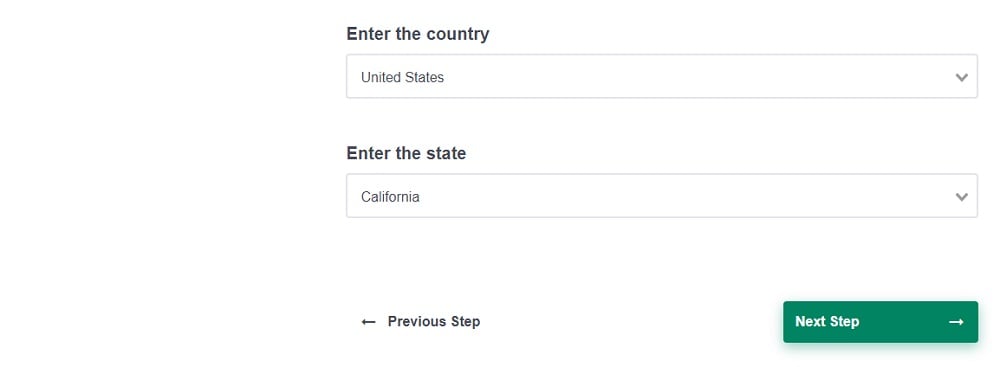
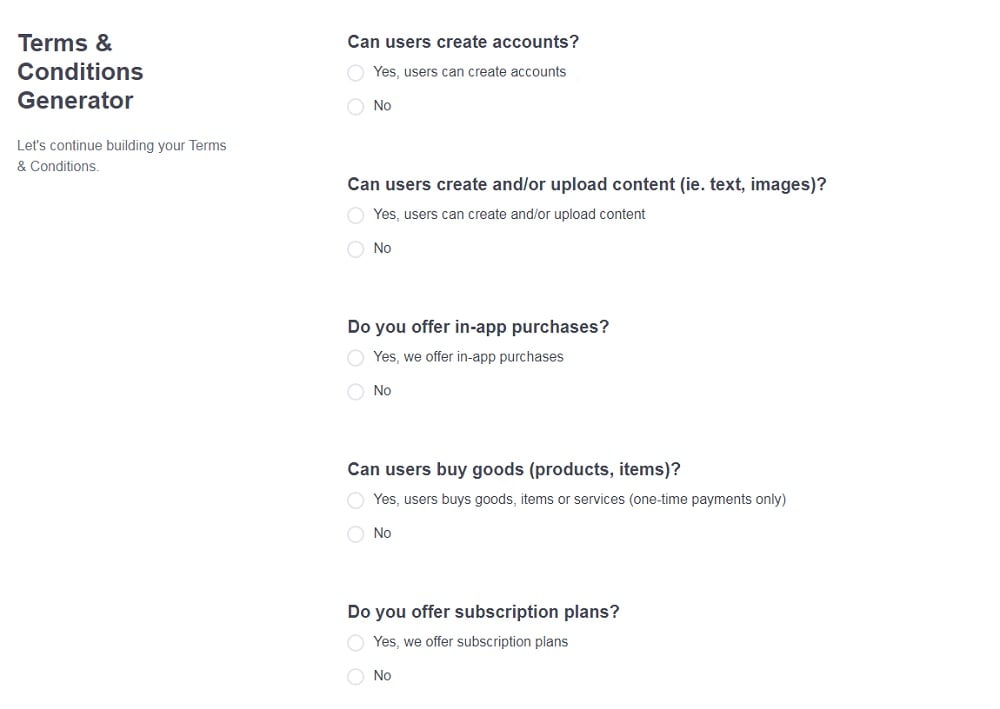
- 1. What is Dropshipping?
- 2. What are Terms and Conditions Agreements?
- 3. Is a Terms and Conditions Agreement Legally Required?
- 4. What Should a Terms and Conditions Agreement Include?
- 4.1. Entire Agreement
- 4.2. Governing Law
- 4.3. Limitation of Liability
- 4.4. Account Termination
- 4.5. Protection of Intellectual Property
- 4.6. Payment Terms
- 4.7. Refunds and Returns Clause
- 4.8. Contact Details
- 4.9. Changing/Updating Terms
- 5. Where Should I Display a Terms and Conditions Agreement?
- 5.1. Website Footer
- 5.2. Checkout Screen
- 5.3. Account Registration Form
- 6. Conclusion
What is Dropshipping?
In short, a dropshipping business allows you to sell goods to customers without storing or distributing the stock yourself.
You source items you want to sell from suppliers or retailers, then you sell them to consumers through your ecommerce store, and you let a third-party distributor handle stock distribution and delivery.
Dropshipping gives people the flexibility to sell a variety of goods without worrying about finding a warehouse to store stock or dealing with shipping logistics. However, you're still running an ecommerce business, which means you need key policies such as a:
What are Terms and Conditions Agreements?

Essentially, a Terms and Conditions agreement sets out what rules customers must follow if they wish to buy from you. They're a contract between you and the customer. You agree to sell someone a product if they abide by your Terms and Conditions.
A Terms and Conditions agreement might also be called something like the Terms of Service or Terms of Use. They're all just different names for the same thing.
Is a Terms and Conditions Agreement Legally Required?
There's no legal requirement to have a Terms and Conditions agreement. However, just because it's not legally required doesn't mean you shouldn't have one.
With Terms and Conditions agreements, you can:
- Formally declare ownership over trademarks like your website logos and slogans
- Limit your liability i.e., determine what you can and can't be held responsible for
- Set out which country's laws govern the contract between you and your customers
- Terminate user accounts or refuse to serve someone if they violate your rules
- Help prevent people from abusing your website or content
Terms and Conditions agreements can offer you some legal protection if they're drafted properly.
What Should a Terms and Conditions Agreement Include?

Even if your Terms and Conditions agreement is only a few clauses long, you still need to cover a few key areas:
- The contractual nature of the agreement
- Which laws apply to your agreement
- The extent of your liability
- When you can terminate a user's account
- What counts as your intellectual property (IP)
- Your payment terms (if applicable)
- Your refund and returns details (if applicable)
- How people can contact you if needed
You should also touch on when you last updated your Terms and Conditions agreement, and explain you have the right to amend your Terms and Conditions at any time.
Let's break down each of these areas to see how you might cover them in your own Terms and Conditions agreement.
Entire Agreement
Be clear that your Terms and Conditions agreement constitutes the "entire agreement" between you and customers.
The wording for such a clause is straightforward. Here's an example from Bluecrate. It's short, clear, and easy for the average consumer to make sense of:

Aim for something this straightforward in your own Terms and Conditions agreement.
Governing Law
Remember, when you're a dropshipping business, your customers could be based anywhere in the world. So, it's important to set out which local or national laws apply if there's a disagreement between you and a customer.
Here's a simple example of a clause that covers this, from Adored Vintage:

Don't make this clause overly complicated. A line or two is enough.
Limitation of Liability
While you must accept some liability if you're running a dropshipping store, you don't want to be liable for every single thing that could go wrong when a customer visits your website. So, typically, you want to restrict liability for the following:
- Inaccuracies or omissions
- Failure to meet customer expectations
- Third-party content
- Website downtime
First, be clear that you're not responsible if a customer relies on information which may be inaccurate. This is especially important if you're a dropshipper, since you're not inspecting products before they're shipped for sale, so you don't always have the very latest product information to hand.
Here's how Bluecrate handles this issue. It's not the company's fault if customers rely solely on the website content:

And the company is not responsible if a product doesn't meet a customer's expectations:

Next, limit your liability for third-party content. You don't want to be liable if a customer clicks on a third-party link and it damages their device in some way. Confirm that if the customer has a problem with the third-party content, they must take it up with that company, not you.
Partake Foods has a good example clause for this:

Finally, you can't guarantee that your website will work perfectly 100% of the time, so state that you won't be liable for any loss incurred by the client due to website downtime.
However, since you can't exclude all liability, be clear that you'll only be held liable to the extent set out in the governing law. In other words, you won't pay any more damages than you're legally required to pay.
Again, Partake Foods sets all this out well in its "Disclaimer of Warranties" clause. First, it doesn't promise that the website always works properly:

The company then limits what damages it will pay, to the extent permitted by law:
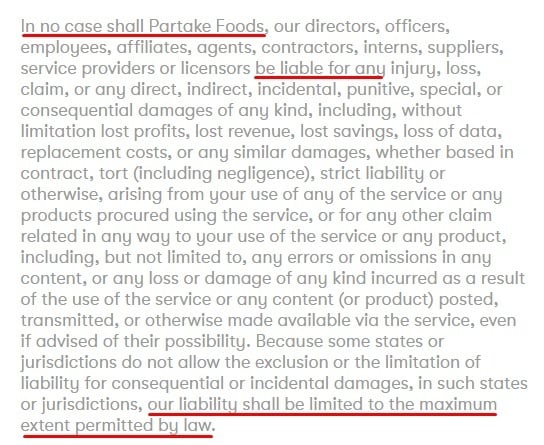
This section of your Terms and Conditions agreement is extremely important. If it's not drafted properly, it leaves you vulnerable to costly disputes, so get legal advice if you're unsure how to draft it.
Account Termination
You want to ensure that you can quickly terminate someone's account, or refuse to sell them products, if they violate your rules. By setting out the reasons when you might terminate an account in your Terms and Conditions agreement, there's less chance of a customer disputing your decision.
FragranceNet, for example, calls this the "Termination of Usage" clause. If a customer violates the Terms and Conditions in any way, the company can terminate that person's account without warning.
FragranceNet reserves the right to use "its sole discretion" to determine if someone's violated the Terms and Conditions agreement. This is good phrasing because it's far easier to justify an account termination this way:

A good general rule to follow is this: keep the account termination clause broad, if you can.
Protection of Intellectual Property
To prevent anyone from misusing your trademarks or IP belonging to your suppliers, set out what is protected in your Terms and Conditions agreement. Be clear that no one can sell, use, or modify IP belonging to you or your suppliers, and they can't impersonate your store in any way.
Here's an example from Inspire Uplift. It's clear that all website content could be considered the IP of Inspire Uplift or its suppliers, and so no customer can share or use it without permission:
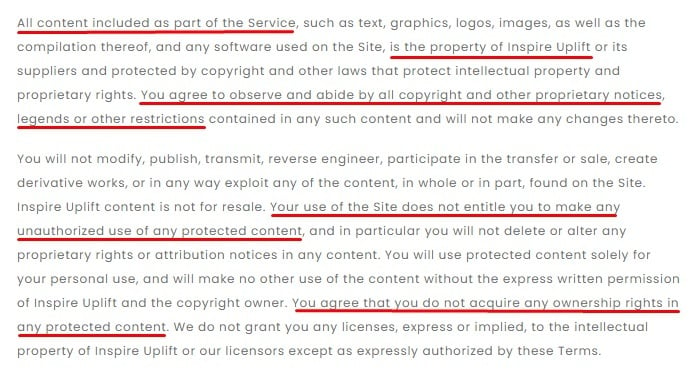
Payment Terms
Your payment terms should cover two things.
First, be clear that you have the right to reject a customer's order. As a dropshipping store, you might be targeted by other merchants looking to sell your goods for higher prices, so you might want to reserve the right to block such sales.
Then, explain that you can't process customer orders unless they provide you with accurate, up-to-date payment details.
Here's an example clause from Adorned Vintage that reserves the right to reject or limit the quantities in orders at the company's "sole discretion." Users are also told that they're agreeing to provide current, complete and accurate purchase information when making an order:

Again, "sole discretion" serves to give you more power to refuse sales where appropriate.
Refunds and Returns Clause
It's best to have a dedicated Return Policy for your dropshipping website. However, for completeness, it's good practice to include the key terms of your Return Policy in your Terms and Conditions agreement.
Gymshark, for example, does this well. It's clear that customers can return items for a refund via the same payment method they used:

The agreement also sets out the process for making returns, and confirms that the company might not always accept returns:

Direct your customers to your Return Policy for more details, but include the most critical parts of your Return Policy in your Terms and Conditions agreement.
Contact Details
Make it simple for customers to contact you for further details regarding your Terms and Conditions agreement. All you need to include is a telephone number, email address, or mailing address for customers to reach you at.
Here's an example from Partake Foods:

Ideally, you should provide more than one method of contacting you, but at least one will suffice.
Changing/Updating Terms
You have the right to update your Terms and Conditions or make any changes as you see fit. However, it's important your customers understand this, so highlight it in your Terms and Conditions agreement.
Also let users know how you'll notify them of any updates, or how they can find this out on their own.
Again, Partake Foods has a decent clause for this. It's short, clear, and doesn't leave any room for misunderstandings:
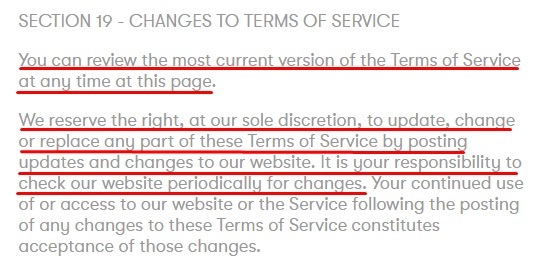
It's also worth including links to your other key policies such as your Privacy Policy and Return Policy. Again, these links aren't required, but they make it easier for your customers to understand what's expected of them when they're shopping with you.
Where Should I Display a Terms and Conditions Agreement?

There are a few places where customers might expect to find your Terms and Conditions agreement across your website or mobile app.
Website Footer
People usually expect to find a policy like your Terms and Conditions in the website footer i.e. the bottom of each page. So, put a link to your Terms and Conditions agreement somewhere beside your other key documents in the footer.
Here's an example from FragranceNet, who links to its Terms of Use in the "Customer Support" section of the website footer:

In a mobile app, the equivalent of this would be adding a link to your Terms and Conditions agreement to a relevant menu, such as a Legal or About menu.
Here's an example from the WeatherBug app:

Checkout Screen
Give people another chance to review your Terms and Conditions before they purchase anything from your store by placing a link to your Terms and Conditions agreement on the checkout page.
Here's an example from OwlCrate, where the link is provided at the point where customers can move on to provide their shipping information:

Account Registration Form
Before someone opens an account with you, whether it's to dropship with you or make a purchase, they should have the chance to read your Terms and Conditions agreement.
Place an obvious link to your Terms and Conditions agreement somewhere on the account registration page. Here's another example from OwlCrate:

Since there's no legal requirement for a Terms and Conditions agreement, you don't need to confirm that someone read your Terms and Conditions agreement when they're checking out or opening an account.
However, you might choose to use a clickable checkbox that people can tick to show they've read, understand and agree to your Terms and Conditions, especially if you want their consent to marketing content.
Here's an example of a clickable box from HELM Boots:

Conclusion
Your Terms and Conditions agreement serves as a legal contract between you and your customers. So, although they're not legally required, Terms and Conditions agreements can offer you some legal protection and help you resolve customer disputes more quickly.
There's no rule for how long a Terms and Conditions agreement should be, but it should include, at minimum, rules regarding:
- Which laws govern the agreement
- When you will (and won't) be held liable
- Your key return and refund terms
- Your payment terms
- When you can terminate someone's account
- What constitutes protected intellectual property
It should also be clear that your Terms agreement is a legal contract, and that it constitutes the whole agreement between you and the customer.
Display a link to your Terms and Conditions agreement somewhere obvious on your website so customers have a chance to review the contract before purchasing from your dropshipping store.


